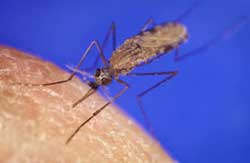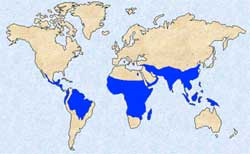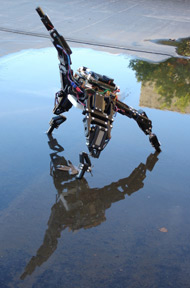A large study weighs up the existing evidence on the impact of GM crops on local insect life, providing some much-needed scientific rigour to the GM debate.
In Europe, the ‘GM debate‘ about the merits and dangers of genetically-modified (GM) crops is a particularly heated one. There is a sense of unease about the power of modern genetic technology, and a gut feeling that scientists are ‘playing God’. These discontents are stoked by the anti-GM camp, who describe GM crops with laden and fear-mongering bits of unspeak like ‘Frankenstein foods’ and ‘unnatural’.
 In a debate so fuelled by emotion and personal values, scientific research and a critical analysis of the evidence rarely gets a look-in. But science has to grudgingly admit some blame in this, because there is actually precious little research on the safety of GM crops. And many of the studies that have been done were short-term and poorly replicated.
In a debate so fuelled by emotion and personal values, scientific research and a critical analysis of the evidence rarely gets a look-in. But science has to grudgingly admit some blame in this, because there is actually precious little research on the safety of GM crops. And many of the studies that have been done were short-term and poorly replicated.
A lack of research is dangerous. It provides opening for people on either side of the debate to quote single, small studies as canon and brushing aside any research that contrasts with their stances.
Adding evidence to the debate
Michelle Marvier and colleagues from Santa Clara University, California, are trying to change all that. They have analysed over 42 field experiments on GM crops to get an overall picture about their safety. The technique they used is called meta-analysis, a statistical tool that asks “What does everyone think?” It works on the basis that individual small studies may be far from conclusive, but pooling their results together can lead to stronger and more accurate results.
They looked at three strains of GM-crops that had been modified with genes from a soil-dwelling bacterium called Bacillus thuringiensis. The transferred genes are responsible for producing a number of biological (and therefore ‘natural’) insecticides. When moving them across to plants, geneticists typically try to match the insecticide to the pest they are trying to fight. (In the image on the right, Bt-peanut leaves are protected from the damaging European corn borer)
The toxins are delivered at high dosages to pests, but are restricted to the plant (and sometimes even to particular tissues). They can also be added to the chloroplast genome, which is quite separate form the plant’s nuclear DNA. This stops them from being transferred to other plants.
The hope is that these so-called ‘Bt crops’ can help to minimise the collateral damage of less targeted insecticide sprays. In theory, only pest insects that eat valued crops are killed, while the rest of the ecosystem is unharmed.
The results
That’s what Marvier set out to test. She looked at field experiments which tested the impact of caterpillar-resistant cotton and maize plants on the abundance of other groups of insects and invertebrates.
She found that these other creatures are found in greater numbers in fields containing the caterpillar-resistant GM plants, compared to those sprayed with conventional insecticides. However, the GM crops also led to slightly lower numbers of non-targeted insects compared to fields where no GM crops and no insecticides were used.
The results stayed the same even when Marvier analysed them in more detail. For example, she found much the same thing when she only looked at experiments that had been published in peer-reviewed scientific journals.
So assuming that Bt crops do indeed reduce the use of insecticides (and that’s far from proven), then they will also, as claimed, reduce the collateral damage caused by these chemicals. But they’re not as good for the environment as using no insecticides at all, be they engineered or sprayed.
The bigger picture
 At the local level, Marvier’s study provides some much-needed scientific backbone to the GM debate. But the real decisions need to be weighed up at a larger level. For example, it’s all well and good to say that a no-insecticide, no-GM field is the best solution, but that leaves farmers in a bit of a lurch.
At the local level, Marvier’s study provides some much-needed scientific backbone to the GM debate. But the real decisions need to be weighed up at a larger level. For example, it’s all well and good to say that a no-insecticide, no-GM field is the best solution, but that leaves farmers in a bit of a lurch.
One of the big criticism levelled against organic farming is that it leads to lower yield than other practices and requires more agricultural land to be viable and that deals a bad hand to farmers in the developing world. This in turn could lead to deforestation and habitat loss.
On the other hand, Marvier advises caution when interpreting her work. This study has revealed just one benefit of GM crops and even then, only for one specific type of genetic modification. Many of the studies involved isolated patches of land, rather than entire farming systems, where the situation is more subtle. Not all non-GM crops are sprayed with insecticides, while not all GM crops are free from them.
Any benefits must also be weighed against potential health or environmental risks, and again, these must be researched carefully.
To Marvier, the clearest message from her study is that we have started to accumulate enough data to look at this issue from an empirical, evidence-based point of view. If we are to make sound decisions, there is little room for anecdotal evidence or knee-jerk responses guided by personal philosophy.
Bt hypocrisy
For example, there is a certain irony to the opposition to Bt crops. Because its insecticides are ‘natural’, the bacterium is one of the few pesticides that organic farmers are allowed to spray onto their crops.
The bacteria of course use the exact same genes that are transplanted into Bt-engineered crops. Some may argue that this method is better because it is more ‘natural’, because the genes stay within the organism they were intended for. But is that really better?
Wholesale Bt spraying is a crude technique than the specific and targeted use of Bt-engineered crops. It means that the surrounding land is also covered in the bacteria and creatures other than pests are exposed to its entire gamut of toxins. And because farmers need constant supplies of the bacteria, it soaks up more money.
Reference: Marvier, McCreedy, Regetz & Kareiva. 2007. A meta-analysis of effects of Bt cotton and maize on nontarget invertebrates. Science 316: 1475-1477.
Technorati Tags: GM crops, genetic modification, GM safety, GM environment, GM debate, insecticides, Michelle Marvier, Peter Kareiva, Bt crops,
Related stories on genetic modification:
Genetically-modified mosquitoes fight malaria by outcompeting normal ones
Magnifection: mass-producing drugs in record time
Feed the world – turning cotton into a food crop
Filed under: Animal kingdom, Biotechnology, Ecology, Environment, Genetics, GM, Insects & arthropods, Invertebrates, Plants, Technology | 1 Comment »
![]() Compare a photo of yourself all cleaned up for a night out with another one first thing the next morning, and you’ll begin to appreciate the problems that people working on face recognition software encounter.
Compare a photo of yourself all cleaned up for a night out with another one first thing the next morning, and you’ll begin to appreciate the problems that people working on face recognition software encounter. While some unfeasibly lucky people look great from all angles, most of us have to contend with a lottery of lighting conditions, odd angles, stupid expressions, stupider poses and the ravages of age. Faced with this unavoidable variability, it’s no wonder that automatic software flounder when tasked with comparing images to stock photos, like those in passports.
While some unfeasibly lucky people look great from all angles, most of us have to contend with a lottery of lighting conditions, odd angles, stupid expressions, stupider poses and the ravages of age. Faced with this unavoidable variability, it’s no wonder that automatic software flounder when tasked with comparing images to stock photos, like those in passports.






 By cross-breeding individuals with desirable qualities, farmers have been tinkering with the genes of both animals and plants for centuries. Traditionally, the process has been a bit messy. Genes don’t always easily translate into physical characteristics, so there is a certain amount of trial-and-error involved.
By cross-breeding individuals with desirable qualities, farmers have been tinkering with the genes of both animals and plants for centuries. Traditionally, the process has been a bit messy. Genes don’t always easily translate into physical characteristics, so there is a certain amount of trial-and-error involved. Morris, together with
Morris, together with 












 Robots have been used for years to perform structured, repetitive tasks. As engineering has advanced, their movements have become more and more stable and life-like.
Robots have been used for years to perform structured, repetitive tasks. As engineering has advanced, their movements have become more and more stable and life-like. These superlative weapons gave the Muslims a great advantage, and their blacksmiths carefully guarded the secret to their manufacture. The secret died eventually died out in the eighteenth century and no European smith was able to reproduce their method.
These superlative weapons gave the Muslims a great advantage, and their blacksmiths carefully guarded the secret to their manufacture. The secret died eventually died out in the eighteenth century and no European smith was able to reproduce their method. Riebold’s team solved this paradox by analysing a Damascus sabre created by the famous blacksmith Assad Ullah in the seventeenth century, and graciously donated by the Berne Historical Museum in Switzerland.
Riebold’s team solved this paradox by analysing a Damascus sabre created by the famous blacksmith Assad Ullah in the seventeenth century, and graciously donated by the Berne Historical Museum in Switzerland.
 Currently, all MAbs are grown using mammalian cells and over the past twenty years, a variety of other hosts from insects to bacteria to yeast have been considered as replacements in the search for efficiency. But all these choices have crippling flaws, with the most significant being massively lengthened development times.
Currently, all MAbs are grown using mammalian cells and over the past twenty years, a variety of other hosts from insects to bacteria to yeast have been considered as replacements in the search for efficiency. But all these choices have crippling flaws, with the most significant being massively lengthened development times.


